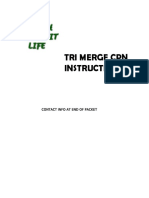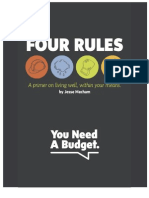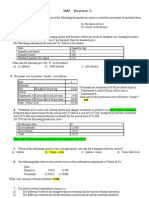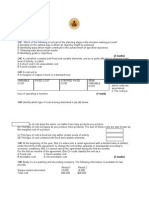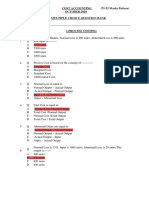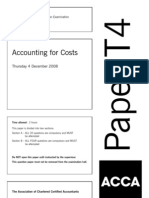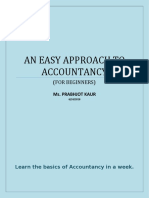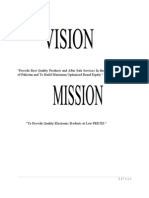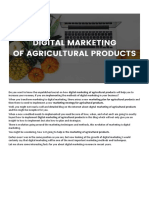Cost 2023-May
Uploaded by
DAVID I MUSHICost 2023-May
Uploaded by
DAVID I MUSHIEXAMINATION : FOUNDATION LEVEL
SUBJECT : COST ACCOUNTING
CODE : A4
EXAMINATION DATE : TUESDAY, 2ND MAY, 2023
TIME ALLOWED : THREE HOURS (9:00 A.M. – 12:00 NOON)
------------------------------------------------------------------------------------------------------------
GENERAL INSTRUCTIONS
1. There are FOUR questions in this paper.
2. Answer ALL questions.
3. Marks are shown at the end of each question.
4. Show clearly all your workings in the respective answers where applicable.
5. This question paper comprises 7 printed pages.
________________________
Questions & Answers May 2023 Page 39 of 71
QUESTION 1
(a) For each of the questions given below, choose the most correct answer among the four
given alternatives. Indicate your answer by writing the appropriate letter A, B, C or D in
your answer booklet.
(i) Unit cost data can most mislead decisions by:
A. not computing fixed overheads costs
B. computing labour and material costs only
C. computing administrative costs
D. not computing unit costs at the same output level
(ii) The general term used to identify both the tracing and the allocation of accumulated
costs to a cost object is:
A. cost accumulation
B. cost assignment
C. cost tracing
D. conversion costing
(iii) An example of a performance measure with a long-run time horizon is:
A. direct materials efficiency variances
B. overhead spending variances
C. number of new patents developed
D. labour efficiency variances
(iv) The costs that result when a company runs out of a particular item for which there
is a customer demand are:
A. shrinking costs
B. shortage costs
C. stock-out costs
D. EOQ estimation costs
(v) A company has an annual demand (weekly demand = 1⁄52 of annual demand) of
20,800 units, a total of 20 orders per year and a lead time of 15 days. If the cost of
placing an order is TZS.100, what is the reorder point?
A. 1,040 units
B. 857 units
C. 1,560 units
D. 2,080 units
(vi) Which of the following manufactured products would NOT use process costing?
A. Chemical processing
B. 46-inch television sets
C. Construction of a commercial office building
D. Food production
(vii) Walton Corporation wishes to develop a single predetermined overhead rate. The
company’s expected annual fixed overhead is TZS.340,000 and its variable
overhead cost per machine hour is TZS.2. The company’s relevant range is from
200,000 to 600,000 machine hours. Walton expects to operate at 425,000 machine
hours for the coming year. The plant’s theoretical capacity is 850,000 machine
hours. The predetermined overhead rate per machine hour should be:
Questions & Answers May 2023 Page 40 of 71
A. 2.4
B. 2.57
C. 2.80
D. 2.85
(viii) A company that produces a single product had a net operating income of
TZS.79,000 using variable costing and a net operating income of TZS.102,760
using absorption costing. Total fixed manufacturing overhead was TZS.53,040 and
production was 10,400 units both this year and last year. Last year was the first year
of operations. Between the beginning and the end of the year, the inventory level is:
A. decreased by 23,760 units
B. increased by 4,659 units
C. decreased by 4,659 units
D. increased by 23,760 units
(ix) Dodge Limited is considering undertaking a short-term contract to produce and
supply special key rings for a conference organizer. In producing the key ring three
materials are required and the company has these materials in inventory as shown
in the table below:
Material Units in Kg Cost price/kg Scrap value/kg Current
purchase/kg
AB 1,000 kgs TZS.4.00 TZS.3.000 TZS.4.25
CD 250 kgs TZS.2.75 TZS.1.20 TZS.3.20
EF 3,000 kgs TZS.1.50 NIL TZS.2.95
Assume material AB is in regular use by Dodge Limited and the company requires
1,750 Kgs of this material to make the key rings. The relevant cost of this material
to be included in the short-term contract price is:
A. TZS.7,000.00
B. TZS.7,437.50
C. TZS.7,187.50
D. TZS.3,187.50
(x) Given Production at 60% activity, 600 units, material TZS.50 per unit, labour
TZS.20 per unit, direct expenses TZS.5 per unit, factory overheads TZS.20,000
(60% variable) and administration expenses TZS.15,000 (60% fixed). What will be
the total cost per unit for production at 80% capacity?
A. TZS.101,000
B. TZS.126.25
C. TZS.122
D. TZS.122,000
(20 marks)
(b) For each of the following statements, state whether the statement is true or false. Indicate
your answer by writing “TRUE” for the correct statement and “FALSE” for the
incorrect statement in your answer booklet:
(i) In companies that produce masses of identical or similar units of output and
consequently use process-costing systems, it is relatively easy to set standards and
use a standard cost as the cost per equivalent unit.
(ii) In order for a process-costing system to work, all units must be measured in the
same denomination in all the departments within the organization.
(iii) The focus of joint costing is assigning costs to individual products as assembly
occurs.
Questions & Answers May 2023 Page 41 of 71
(iv) Feedback from previous decisions uses historical information and, therefore, is
irrelevant for making future predictions.
(v) Relevant costs are expected future costs that always differ among alternatives.
(10 marks)
(c) Given the following statements, you are required to pair each statement from LIST A
with the item from LIST B appropriately. In pairing the statement with items, write the
roman number from list A against the corresponding letter from list B in your answer
booklet:
LIST A
(i) All the costs incurred from conceptualization to sale of a product, other than those
attributable to production activity, inclusive of administration costs, selling costs,
distribution costs, finance costs and research and development costs.
(ii) When the amount of actual overheads is more than the amount of the overheads
absorbed.
(iii) Is considered as a normal loss of material.
(iv) Is a method of budgeting based on an activity framework and utilizing cost driver
data in the budget-setting and variance feedback processes.
(v) Monitoring the efficient and effective use of the resources employed by an
organization to achieve the desired goals.
LIST B
A. Internal Rate of Return (IRR)
B. Period cost
C. Loss due to careless handling of material
D. Over-absorption of overheads
E. Zero Based Budgeting (ZBB)
F. Operation control
G. Product cost
H. Management control
I. Under-absorption of overheads
J. Activity Based Costing (ABC)
K. Pilferage of material
(10 marks)
(Total: 40 marks)
QUESTION 2
The monthly budgets for manufacturing overhead of a concern for two levels of activity were
as follows:
Capacity 60% 100%
Budgeted production (units) 6,000 units 10,000 units
TZS.‘000’ TZS.‘000’
Salaries and wages 9,600 16,000
Consumables stores 7,200 12,000
Maintenance 8,800 12,000
Power and fuel 12,800 16,000
Depreciation 32,000 32,000
Insurance 8,000 8,000
78,400 96,000
Questions & Answers May 2023 Page 42 of 71
REQUIRED:
(a) Indicate with reasons, which of the items are fixed, variable and semi-variable.
(4 marks)
(b) Prepare a budget for 80% capacity. (10 marks)
(c) Find the total costs, both fixed and variable, per unit of output at 60%, 80% and 100%
capacity (6 marks)
(Total: 20 marks)
QUESTION 3
(a) Standard costing is a control technique which compares standard costs and revenues
with actual results to obtain variances, which are used to stimulate improved
performance.
REQUIRED:
i. Briefly state any four (4) objective/usefulness of standard costing.
(6 marks)
ii. List any four (4) steps that are used in standard costing. (4 marks)
(b) The following is the budgeted data provided by Manengelo Ltd, an iron bar
manufacturing company for the year ended 31st December 2022.
Particulars Amount
Selling price per unit 25,000
Direct material per unit 5,000
Direct labour per unit 5,000
Variable production overhead per unit 2,500
Total fixed manufacturing costs 36,000,000
Total fixed selling expenses 15,000,000
Actual sales in units 7,500
Actual production in units 9,000
Budgeted production in units 10,000
REQUIRED:
Assuming that there is no closing inventory in the year ended 31st December 2021, what
should be the value of closing inventory for the year ended 31st December 2022 under
the marginal costing system as well as the absorption costing system.
(10 marks)
(Total: 20 marks)
Questions & Answers May 2023 Page 43 of 71
QUESTION 4
Kibati Designated Hospital operates a separate department for private parties, called ‘First
Grade’. The department has six (6) beds and the hospital charges a fee of TZS.17,000 per day
per patient. The patient will be however, make their own arrangements for payment of
physician’s fees. During the year 2020, the hospital collected a total fee revenue of
TZS.281,265,000. The actual expenses were as shown in the table below:
Allocation Basis
Patient days Variable Patient days Variable
(TZS.) (TZS.)
Food 44,000,000 -
Staff other than nurses - 2,400,000
Laundry 24,000,000 -
Laboratory and pharmacy 52,000,000 -
Maintenance 7,400,000 -
General administration - 47,400,000
Others 4,960,000 -
132,300,000 49,800,000
Rent of premises in which the department is housed is TZS.80,000,000 per annum. During the
year 2021, it is expected that the aforesaid fixed and variable expenses will go up by 10%. The
rent will increase to TZS.100,000,000. The requirement of nursing staff is as follows:
Annual Patient days Numbers of Nurses
Less than 8000 3
8,000 – 10,000 4
10,000 – 12,000 5
Over 12,000 8
The average salary of nursing staff which was TZS.1,300,000 per nurse per annum in 2020 will
increase to TZS.1,400,000 per annum in year 2021. Patient days of occupancy are expected to
remain constant.
Because of insufficient demand, the hospital is contemplating to close the department.
REQUIRED:
Prepare for the department:
(a) (i) The statement of actual profitability for the year 2020. (5 marks)
(ii) The projected profitability for the 2021. (5 marks)
(b) Calculate the break-even patient days of occupancy for the year 2021.
(2.5 marks)
(c) What increase in fees is required to break-even at year 2020 patient day of occupancy
in year 2021? (2.5 marks)
(d) Mention any five (5) assumptions of Cost Volume Profit analysis.
(5 marks)
(Total: 20 marks)
________________ _______________
Questions & Answers May 2023 Page 44 of 71
You might also like
- Fundamental Accounting Principles 25th Edition PDF100% (1)Fundamental Accounting Principles 25th Edition PDF14 pages
- Credit Repair Secrets - Learn Fast The Basic Strategies To Repair Bad Credit and Fix Your Bad Debt To Improve Your Score, Business, and Personal Finance. 609 Letter Template Included.67% (3)Credit Repair Secrets - Learn Fast The Basic Strategies To Repair Bad Credit and Fix Your Bad Debt To Improve Your Score, Business, and Personal Finance. 609 Letter Template Included.91 pages
- Group II - June 2010 Cost and Management Accounting: The Figures in The Margin On The Right Side Indicate Full MarksNo ratings yetGroup II - June 2010 Cost and Management Accounting: The Figures in The Margin On The Right Side Indicate Full Marks23 pages
- Final Examination Cost Accounting 2019 FinalNo ratings yetFinal Examination Cost Accounting 2019 Final6 pages
- Paper - 4: Cost Accounting and Financial Management Section A: Cost Accounting QuestionsNo ratings yetPaper - 4: Cost Accounting and Financial Management Section A: Cost Accounting Questions47 pages
- Câu Nội dung 1: In Đậm Đáp Án, Ý Kiến Khác Tô ĐỏNo ratings yetCâu Nội dung 1: In Đậm Đáp Án, Ý Kiến Khác Tô Đỏ15 pages
- ACCA Paper F2 ACCA Paper F2 Management Accounting: Saa Global Education Centre Pte LTDNo ratings yetACCA Paper F2 ACCA Paper F2 Management Accounting: Saa Global Education Centre Pte LTD17 pages
- SunwayTes Management Accountant Progress Test 2No ratings yetSunwayTes Management Accountant Progress Test 213 pages
- Management Accounting Level 3/series 3 2008 (Code 3023)100% (2)Management Accounting Level 3/series 3 2008 (Code 3023)14 pages
- Test I. True-False Direction: Write T If The Statement Is Correct and F If It Is Wrong Beside0% (1)Test I. True-False Direction: Write T If The Statement Is Correct and F If It Is Wrong Beside8 pages
- Economic Insights from Input–Output Tables for Asia and the PacificFrom EverandEconomic Insights from Input–Output Tables for Asia and the PacificNo ratings yet
- Salesforce Certified Platform Developer I CRT-450 Exam PreparationFrom EverandSalesforce Certified Platform Developer I CRT-450 Exam PreparationNo ratings yet
- Application of Inventory Management in Construction IndustryNo ratings yetApplication of Inventory Management in Construction Industry3 pages
- Team I - Wingstop - Proposal Slidedeck UpdateNo ratings yetTeam I - Wingstop - Proposal Slidedeck Update39 pages
- Sean Elkan F. Capili Jamella Joy B. Herrera Jade Marie V. Jarito Miguel Cosme TorresNo ratings yetSean Elkan F. Capili Jamella Joy B. Herrera Jade Marie V. Jarito Miguel Cosme Torres5 pages
- Principles and Practice of Marketing: Developing New ProductsNo ratings yetPrinciples and Practice of Marketing: Developing New Products5 pages
- Sales Executive Business Development in Boston MA Resume Martin LairdNo ratings yetSales Executive Business Development in Boston MA Resume Martin Laird2 pages
- Statements Are: Half Yearly Am - (2022-2023)No ratings yetStatements Are: Half Yearly Am - (2022-2023)8 pages
- Dark Purple Woman Photo Customer Service ResumeNo ratings yetDark Purple Woman Photo Customer Service Resume1 page
- Topic 3 - Lecture III - Procurement MethodsNo ratings yetTopic 3 - Lecture III - Procurement Methods20 pages
- Solution Manual, Managerial Accounting Hansen Mowen 8th Editions - CH 18100% (3)Solution Manual, Managerial Accounting Hansen Mowen 8th Editions - CH 1816 pages
- Digital Marketing of Agricultural ProductsNo ratings yetDigital Marketing of Agricultural Products8 pages

